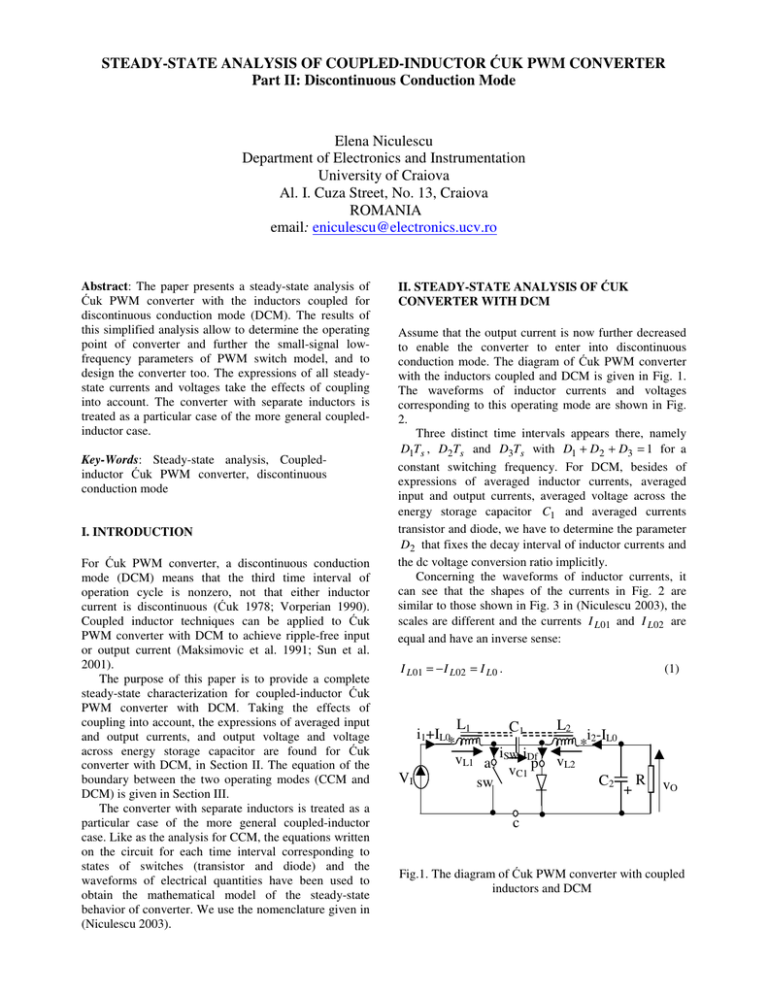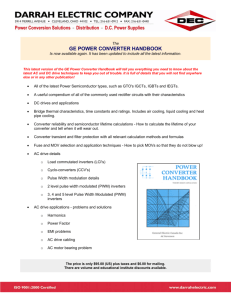PDF995, Job 3
advertisement

STEADY-STATE ANALYSIS OF COUPLED-INDUCTOR UK PWM CONVERTER Part II: Discontinuous Conduction Mode Elena Niculescu Department of Electronics and Instrumentation University of Craiova Al. I. Cuza Street, No. 13, Craiova ROMANIA email: eniculescu@electronics.ucv.ro Abstract: The paper presents a steady-state analysis of uk PWM converter with the inductors coupled for discontinuous conduction mode (DCM). The results of this simplified analysis allow to determine the operating point of converter and further the small-signal lowfrequency parameters of PWM switch model, and to design the converter too. The expressions of all steadystate currents and voltages take the effects of coupling into account. The converter with separate inductors is treated as a particular case of the more general coupledinductor case. Key-Words: Steady-state analysis, Coupledinductor uk PWM converter, discontinuous conduction mode I. INTRODUCTION For uk PWM converter, a discontinuous conduction mode (DCM) means that the third time interval of operation cycle is nonzero, not that either inductor current is discontinuous ( uk 1978; Vorperian 1990). Coupled inductor techniques can be applied to uk PWM converter with DCM to achieve ripple-free input or output current (Maksimovic et al. 1991; Sun et al. 2001). The purpose of this paper is to provide a complete steady-state characterization for coupled-inductor uk PWM converter with DCM. Taking the effects of coupling into account, the expressions of averaged input and output currents, and output voltage and voltage across energy storage capacitor are found for uk converter with DCM, in Section II. The equation of the boundary between the two operating modes (CCM and DCM) is given in Section III. The converter with separate inductors is treated as a particular case of the more general coupled-inductor case. Like as the analysis for CCM, the equations written on the circuit for each time interval corresponding to states of switches (transistor and diode) and the waveforms of electrical quantities have been used to obtain the mathematical model of the steady-state behavior of converter. We use the nomenclature given in (Niculescu 2003). II. STEADY-STATE ANALYSIS OF UK CONVERTER WITH DCM Assume that the output current is now further decreased to enable the converter to enter into discontinuous conduction mode. The diagram of uk PWM converter with the inductors coupled and DCM is given in Fig. 1. The waveforms of inductor currents and voltages corresponding to this operating mode are shown in Fig. 2. Three distinct time intervals appears there, namely D1Ts , D2Ts and D3Ts with D1 + D2 + D3 = 1 for a constant switching frequency. For DCM, besides of expressions of averaged inductor currents, averaged input and output currents, averaged voltage across the energy storage capacitor C1 and averaged currents transistor and diode, we have to determine the parameter D2 that fixes the decay interval of inductor currents and the dc voltage conversion ratio implicitly. Concerning the waveforms of inductor currents, it can see that the shapes of the currents in Fig. 2 are similar to those shown in Fig. 3 in (Niculescu 2003), the scales are different and the currents I L 01 and I L 02 are equal and have an inverse sense: I L 01 = − I L 02 = I L 0 . i1+IL0 * VI L1 (1) L2 C1 i2-IL0 • • * • i vL1 a SW iDfp vL2 vC1 C2 R sw + • c • vO • Fig.1. The diagram of uk PWM converter with coupled inductors and DCM vL1 D1Ts (a) D2Ts iSW iDf D3Ts VI (g) 0 VC1-VI Ts iSW=iL1+iL2 iDf=iL1+iL2 t 0 t Fig.2. The waveforms of inductor currents and voltages for discontinuous conduction mode i1+IL0 di1 V I = dt L1e (b) For the first two time intervals D1Ts and D2Ts , the equation (9), (10) and (11), (12) in (Niculescu 2003) keep their validity and those will be repeated below, for an ease using. So, for 0 ≤ t ≤ D1Ts , IL0 0 t i1 ( ) (2) ( ) (3) di2 (VC1 − VO ) − k c nV I . = dt 1 − k c2 L2 D1TsV I L1e (c) k V I − c (VC1 − VO ) di1 n = dt 1 − k c2 L1 For D1Ts ≤ t ≤ (D1 + D 2 )Ts , IL1D 0 t vL2 di1 =− dt kc VO n 1 − k c2 L1 (VC1 − VO ) − ( ) (4) ( ) (5) V − k c n(VC1 − VO ) di2 . =− O dt 1 − k c2 L2 (d) VC1-VO 0 t VO i2-IL0 VC1 = 1 + di2 V = I dt L2 e (e) 0 i2 (f) D2 D V I = 1 + 1 VO . D1 D2 (6) The above relationships yield the dc voltage conversion ratio IL0 t M= D1TsV I L2 e VO D1 = VI D2 (7) and IL2D 0 For the third time interval ( D3Ts ), the voltages across inductors are nulls: v L1 = v L 2 = 0 . Taking into account that the averaged voltage across the inductors over a switching period are null, the following relationships result: VC1 = V I + VO . t (8) The remark regarding the relationship (8) that is the same as (18) in (Niculescu 2003), made for the converter with CCM, keeps its validity for the converter with DCM. The determination of the conversion ratio M needs the value of parameter D2 too. It is obvious that the conditions of ripple cancellation from the input or output current found for CCM remain unchanged for DCM. The two effective inductances and two parameters of conduction through the inductors hold their expressions as in (Niculescu 2003), that is: (1 − k )L 2 c L1e = 1 1− kc / n ; L 2e = (1 − k )L 2 c 1− kc n 2 I L2D = D1 (D1 + D2 )TsV I D1 (D1 + D2 )V I = . 2 L2 e K 2m R D1V I R D1 D − 2 . K1m K 2 m in Fig. 2 (g), the total rise of i SW (11) I Df = D2 (I L1D + I L 2 D ) = D1 + D 2 D1 D 2 T sV I DV MV I = 1 I = 2 Lem D2 R R . (20) (12) III. BOUNDARY BETWEEN THE CONTINUOUS AND DISCONTINUOUS CONDUCTION MODES (13) during 0 ≤ t ≤ D1Ts should be equal to the total fall in i Df during D1Ts ≤ t ≤ (D1 + D2 )Ts . This means that we have D1Ts × represents the parameter of conduction through an equivalent inductor with the inductance The averaged currents of transistor switch and diode result as follows: D1 I SW = (I L1D + I L 2 D ) = D1 + D 2 (19) D12 TsV I D 2V M 2V I = 1 I = 2 Lem R D 22 R As it can be seen from the waveforms of currents in the transistor and diode, shown as i SW and respectively i Df (17) (10) and further I L0 = 2 Lem f s R Lem = L1e // L2e . (18) For 100% efficiency, the above equation yields VO I L 2 D − V I I L1D VO + V I (16) (9) the expression of the component I L 0 , we use again the relationship of the converter efficiency, that is I L0 = (15) As results, the parameter D2 is given by the formula K em = The calculation of these components of inductor currents needs to find the parameter D2 firstly. In order to find VO (I L 2 D − I L 0 ) = ηV I (I L1D + I L 0 ) . VO MV I = . R R where the quantity Based on the waveforms of inductor currents, the formula of average value of ripple component of inductor currents can be written as: D1 (D1 + D2 )TsV I D1 (D1 + D2 )V I = 2 L1e K1m R I O = I L 2 = I L 2 D − I L0 = D2 = K em ; 2L f 2L f K1m = 1e s ; K2m = 2e s . R R I L1D = Now, we proceed to determine the formula for parameter D2 . For this purpose, we combine the equation (13) with di1 di2 di di + = D 2 Ts × − 1 − 2 dt dt 0≤t ≤ D T dt dt D T ≤t ≤( D + D )T 1s 1s 1 2 s (14) and after the substitution of the corresponding shapes of inductor current and using the relation (8), we find the dc voltage conversion ratio in (7) once more. For a complete characterization of the uk PWM converter operating, we find now the equation of the boundary between CCM and DCM for the coupledinductor case. It is well known that a converter will change the operating mode when the following equality is satisfied: D2 = 1 − D1 . (21) This means that the parameter K em reached its critical value K emcrt = (1 − D1 )2 . (22) The same equation can be derived starting from the equality I L 01 = − I L02 . (23) The above equality defines the condition of passing from CCM to DCM too, if there the parameter K em will have its critical value K emcrt . Also, all these results characterize the uk PWM converter with separate inductors, case in which we have to set k c at zero. IV. CONCLUSION Formally, the dc conversion ratio of uk PWM converter with coupled-inductors and operating in DCM has the same formula as in the separate-inductor case. But, the parameter D2 takes the coupling effect into account, by means of the parameter of conduction through an equivalent inductor with the inductance Lem . The averaged input and output currents, and the averaged currents of transistor and diode as the boundary equation include the coupling effect too. So, the steady-state operating point and the parameters of small-signal lowfrequency model of converter depend on the coupling parameter. Moreover, the steady-state mathematical model developed here supplies the formula of equivalent inductance in the input and output circuits of converter that are entailed by a dynamic analysis of converter based on its equivalent circuit. REFERENCES uk, S., Discontinuos Inductor Current Mode in the Optimum Topology Switching Converter, PESC’78 Record, 1978, pp.105-123 Vorperian, V., Simplified analysis of PWM converters using model of PWM switch, Part II: Discontinuous conduction mode, IEEE Trans. on Aerospace Electronic Systems, Vol. 26, 1990, pp. 497-505 Maksimovic, D., and uk, S., A unified analysis of PWM converters in discontinuous modes, IEEE Trans. on Power Electronics, Vol. 6, 1991, pp. 476490 Lee, Y. S., Cheng, D. K. W. and Wong, S. C., A New Approach to the Modeling of Converters for SPICE Simulation, IEEE Trans. on Power Electronics, Vol. 7, No. 4, 1992, pp. 741-753 Sun, J., Mitchell, D.M., Greuel, F., Krein, P.T., and Bass, R.M., Averaged Modeling of PWM Converters Operating in Discontinuous Conduction Mode, IEEE Trans. on Power Electronics, Vol. 16, No. 4, 2001, pp. 482-492 Niculescu, E., Steady-State Analysis of CoupledInductor uk PWM Converter. Part I: Continuous Conduction Mode, 11th International Symposium on System Theory, Automation, Robotics, Computers, Informatics, Electronics and Instrumentation, Romania, 2003

